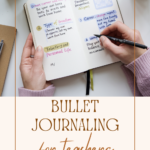For teachers contemplating a career change, finding clarity in the chaos can be daunting. Between lesson planning, grading, and soul-searching, it’s easy to feel overwhelmed. Enter bullet journaling: a simple, flexible system to organize your thoughts, track your progress, and set goals as you transition into a new chapter. These bullet journaling tips for teachers will help you get your thoughts in order.
If you’re ready to leave the classroom for new opportunities, here are 8 bullet journaling tips tailored to help teachers plan their career pivot effectively.
(This post may contain affiliate links that won’t change your price but will share some commission. As an Amazon Associate, I earn from qualifying purchases. Please read our disclosure policy for more information.)
Table of Contents
- 1. Define Your “Why”
- 2. Brain Dump Your Career Options
- 3. Create a Career Transition Tracker
- 4. Set SMART Goals
- 5. Create a Skills Inventory
- 6. Track Professional Development
- 7. Prioritize Self-Care
- 8. Visualize Your Dream Life
- Final Thoughts on Bullet Journaling Tips for Teachers
1. Define Your “Why”
Transitioning out of teaching often stems from personal or professional dissatisfaction. Use your bullet journal to explore your reasons. Create a spread with prompts like:
- What do I want more of in my career?
- What do I want to leave behind?
- What are my long-term goals?

This exercise clarifies your motivations and helps keep your focus on the bigger picture.
2. Brain Dump Your Career Options
Teachers have a wealth of transferable skills, but narrowing down options can be tough. Dedicate a few pages in your journal to a brain dump:
- List careers that interest you.
- Highlight skills you enjoy using (e.g., communication, organization, leadership).
- Note areas you’d like to learn more about.

Revisiting this spread can help you identify patterns and promising pathways.
3. Create a Career Transition Tracker
Map out your career change journey with a tracker. Include milestones like:
- Updating your resume.
- Networking with professionals in your field of interest.
- Taking online courses or earning certifications.
- Applying for new roles.

Use symbols or color-coding to visualize your progress and stay motivated.
4. Set SMART Goals
Use your bullet journal to break down your career transition into SMART goals (Specific, Measurable, Achievable, Relevant, Time-bound). For example:
- Specific: Research three alternative career paths by [date].
- Measurable: Apply to five positions by [date].

Track these goals in a monthly or weekly spread to hold yourself accountable.
5. Create a Skills Inventory
Teaching equips you with a treasure trove of skills. Use a bullet journal spread to list them under categories like:
- Communication: Public speaking, writing, interpersonal skills.
- Organization: Time management, lesson planning.
- Leadership: Team collaboration, classroom management.

This inventory will remind you of your strengths and give you confidence as you explore new career options.
6. Track Professional Development
If your new career requires additional skills, track your progress with a professional development spread. Include:
- Online courses or certifications.
- Books to read.
- Webinars or workshops to attend.
- Notes or takeaways from learning experiences.

Tracking this progress not only keeps you organized but demonstrates your commitment to potential employers.
7. Prioritize Self-Care
Changing careers can be emotionally draining. Use your bullet journal to prioritize self-care:
- Track habits like exercise, sleep, and relaxation.
- Include affirmations or gratitude logs.
- Schedule breaks to recharge.

A dedicated self-care spread ensures you’re supporting your mental and emotional well-being during this transition.
8. Visualize Your Dream Life
As you embark on this new journey, it’s essential to stay inspired. Dedicate a page in your bullet journal to visualize your dream career and lifestyle. Draw or write about:
- The type of work you’ll be doing.
- The flexibility and freedom you’ll enjoy.
- How your career change will impact your personal life.

This visualization can serve as a guiding light when doubts creep in.
Final Thoughts on Bullet Journaling Tips for Teachers
Bullet journaling is more than a productivity tool—it’s a means of self-discovery and empowerment. By dedicating time to reflect, plan, and track your career change, you’ll build the confidence and clarity needed to take the leap.

If you’re a teacher ready to explore life beyond the classroom, embrace bullet journaling as your secret weapon. It’s not just about leaving teaching; it’s about designing the career and life you truly want.












